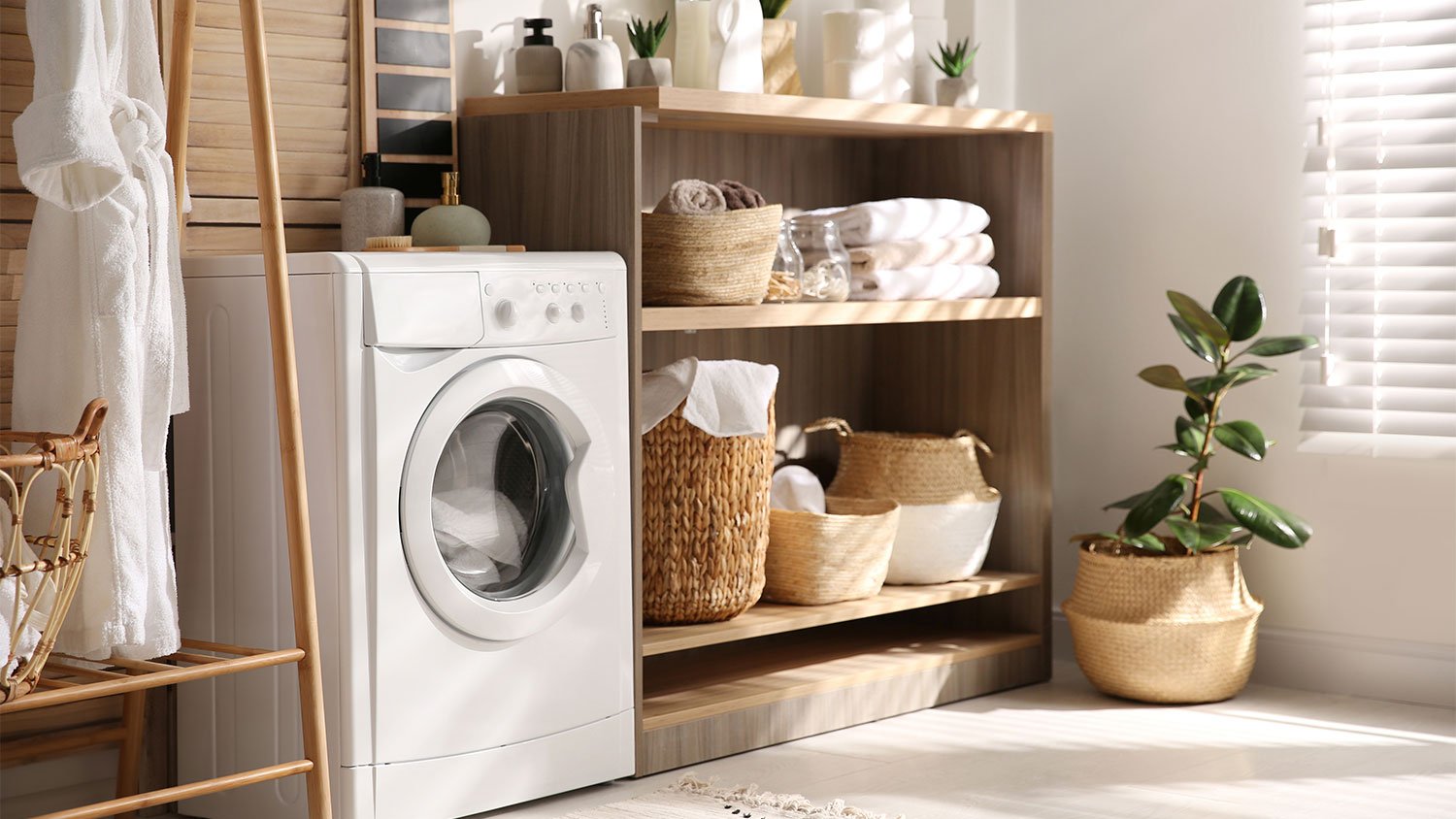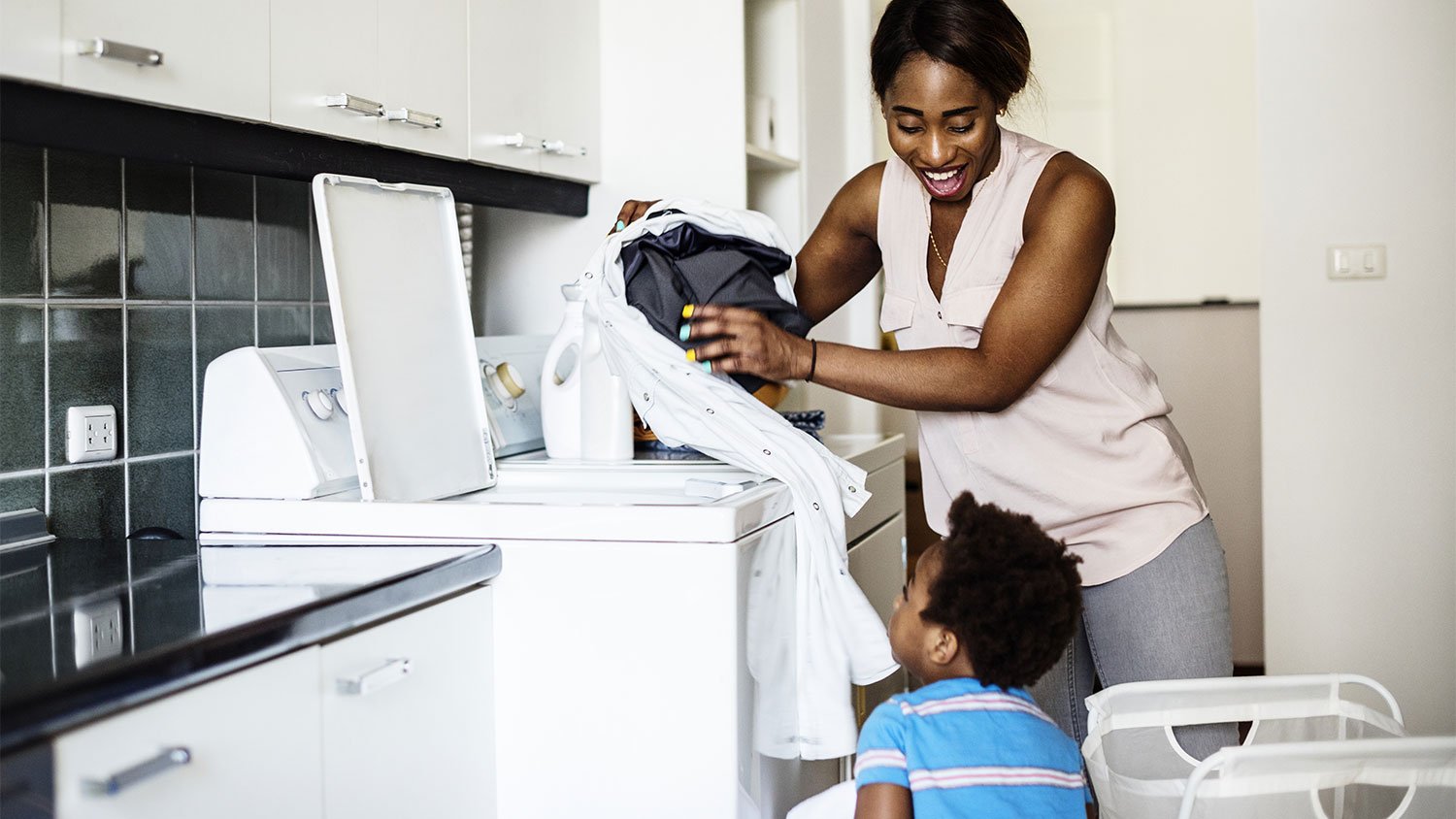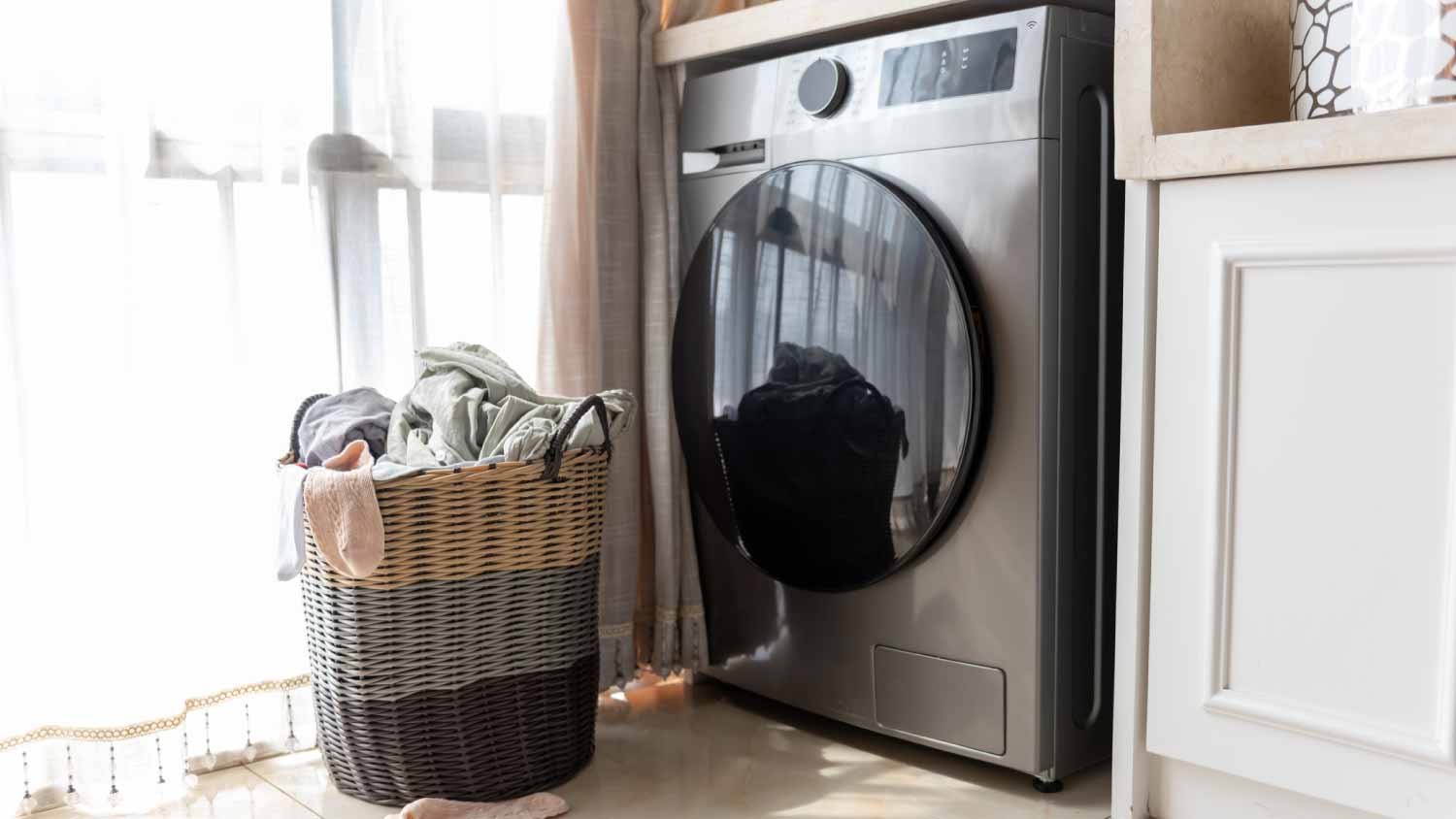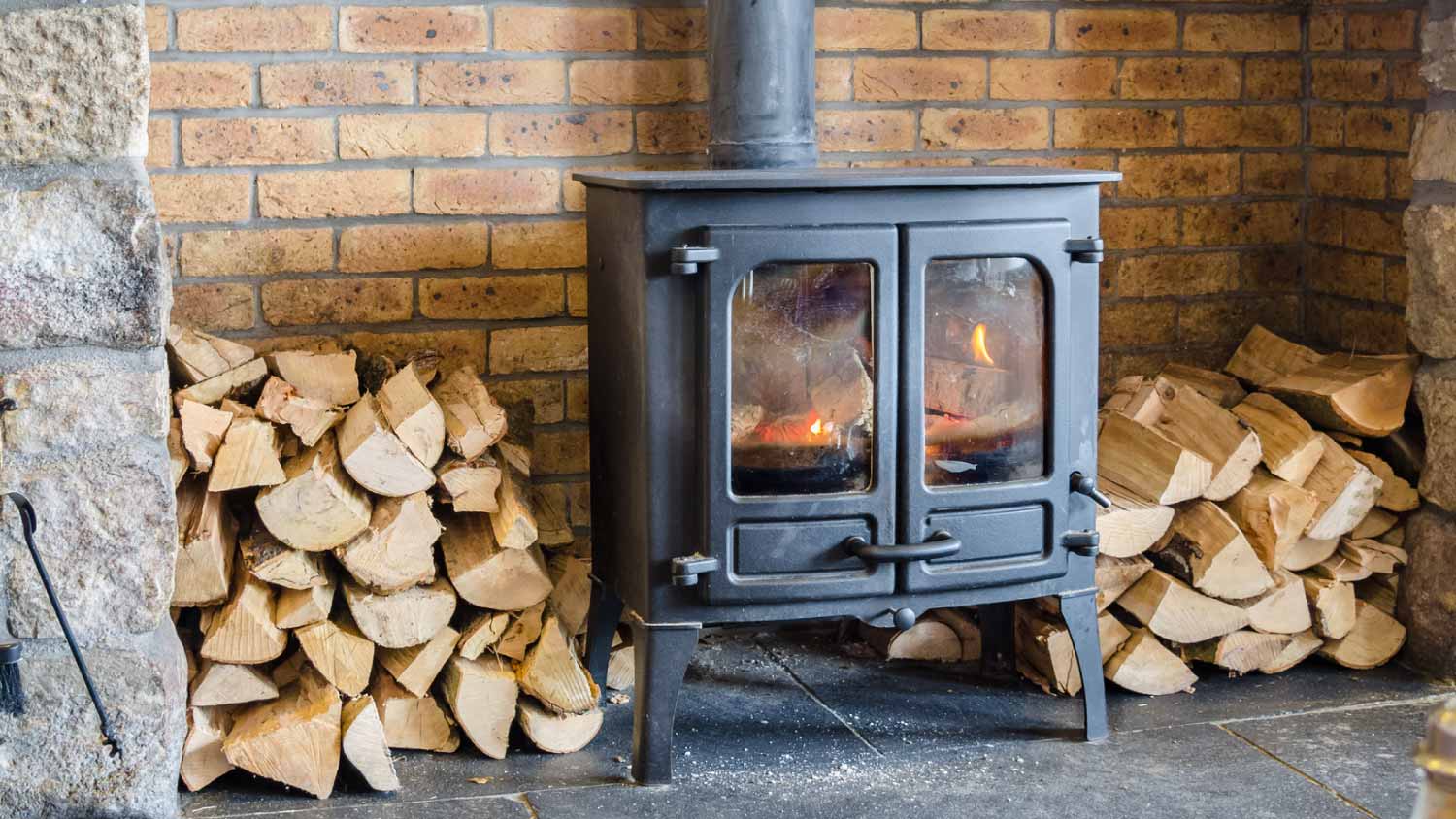How to Choose a Washer and Dryer: 11 Things to Consider
Many things in life sort themselves out in the wash


If your washer and dryer are suddenly on the fritz, it's easy to fall down the shopping rabbit hole of endless options, price points, and flashy features. The varieties of washers and dryers are pretty extensive: front or top-loading, high-efficiency or standard-efficiency, gas or electric.
Check out these tips on how to choose a washer and dryer for your budget, cleaning needs, and home design so you can tackle that growing laundry pile.
1. Purchasing Individually vs. A Set
You have options when it comes to figuring out how to choose a washer and dryer. It's typically a good move–most of the time–to purchase a washer and dryer as a set, but it is not always necessary.
Replacing them at the same time means they'll run at the same capacity, maintain similar efficiency levels, and—most importantly—be the same age. If your old washer recently broke down but your dryer is still hanging on, it’s only a matter of time before you’ll need to replace that as well. Additionally, when you purchase the two at the same time, you'll likely get a discount compared to buying them separately.
Here's a quick note on washer-dryer combos: While these compact models can save space in small apartments, remember that you won't have the option to replace them separately if half of the system breaks down.
2. Size and Layout

The size of your washer and dryer is one of the most important factors in your decision. Review the measurements of the units and measure the space in your home. Consumer Reports recommends including at least 6 inches behind both your washer and dryer for the water and venting hookups. You should plan for at least 2 to 3 inches between your machines themselves, unless, of course, you choose a stacking pair.
The layout of your laundry area will also impact the choice between side-by-side or stacked washer and dryer units. Some homes feature more space horizontally, which is ideal for accommodating side-by-side units. If you have a broader area available, this configuration provides easier access for loading and unloading your appliances. On the other hand, homes with limited floor space might benefit from stacked washer and dryer setups. These vertically aligned units are a great space-saving solution, especially in smaller apartments or compact laundry closets.
3. Capacity
A washer and dryer's capacity indicates if you can toss that large comforter or a pile of towels in the machine without risking damage or an incomplete cleaning. Washers range from 2.5 cubic feet up to 6.2 cubic feet of capacity, while dryers go from 3.4 to 9.2. The smaller ends of this range refers to compact washers and dryers, while the higher numbers are best for bigger loads of clothing.
If you have a large family that has a constant cycle of laundry, opt for the larger capacity to avoid overloading the machine and straining it over time. Small machines also use more energy to get your clothing dry.
4. Front-Loading vs. Top-Loading

Front-loading washers are the hot commodity on the market; most HE washers and dryers have front-loading setups, for example. According to the New York Times, most consumer ranking systems only provide “excellent” ratings to front-loading models.
Front-loading washers have a reputation for getting a better overall clean, removing more stains, and using less water and energy. Choosing a front-loading dryer is not as crucial, but they are easier to stack with front-loading washers–if you’re looking to save space.
Top-loading washers and dryers cost a bit less than their front-loading varieties. Top-loaders are a bit of a classic choice and many washers have an agitating pole in the middle.
Top-loaders are a bit easier to maintain because they are less likely to accumulate mold than front-loading machines. They also have shorter cycle times than front loaders. However, most models use more water and energy to both wash and dry your items, and some agitating models can risk damage to your more delicate items.
5. Impeller vs. Agitator in Top-Loading Washers
When it comes to top-loading washers, the choice often boils down to two primary designs—impeller and agitator. These mechanisms dictate how the washer cleans your clothes, and each offers distinct advantages.
Agitators are the more traditional style. Easily recognizable by their central column that juts up from the bottom of the drum, agitators move clothes around vigorously to loosen dirt and stains. This movement can be quite robust and is effective for cleaning heavily-soiled items or fabrics that require more agitation for thorough cleansing.
Impellers use newer technology. Instead of a central column, impellers feature a low-profile, cone or disc-shaped component at the bottom of the drum. They work by creating a gentle yet powerful current of water, allowing clothes to rub against each other to dislodge dirt and grime. Impellers are known for their larger capacity, as they take up less space in the drum, enabling them to handle bulkier loads or larger items like comforters and blankets.
The choice between an impeller and an agitator often comes down to the type of laundry you typically do, and your personal preferences. Agitators are generally better suited for handling tough stains and more substantial loads but may be harsher on delicate fabrics. Conversely, impellers provide a gentler wash and are ideal for more modern, energy-efficient machines, excelling in handling larger loads or items that require less aggressive cleaning.
6. Energy Efficiency
The largest benefits of an Energy Star washer and dryer is the savings on your utility bills and the smaller impact on the environment. These machines use less water and fossil fuels overall, cutting down on each load's carbon footprint.
High-efficiency washers and dryers can typically handle larger loads and complete cycles in less time, making your day-to-day laundry life a lot easier as well.
However, the upfront costs are still significantly higher than a traditional top-loading agitator with standard efficiency ratings. So, making the right choice for your home may come down to your initial budget.
Keep in mind that energy and water costs can affect how much the washer and dryer will cost you in the long run. High-efficiency models—models that use less water and dry clothing quicker—make a difference, for example. According to The Department of Energy, Energy Star-certified washers use 25% less energy and dryers use about 20% less compared to traditional models.
7. Gas vs. Electric Dryers
Gas dryers earn the award for faster drying power with less energy. The gas heating system heats up quickly and maintains consistent energy throughout, meaning your clothing dries faster. Gas-powered energy also typically costs less than electric on your utility bill.
On the other hand, you'll need a gas hookup in your home, which can cost an average of $20 per linear foot, so keep this in mind if you don't already have one set up. A gas dryer will also cost about $100 more upfront than an electric model.
So the gas versus electric debate is similar to comparing top and front-loading or standard and HE models: Spend more upfront for lower operations costs.
8. Vented vs. Ventless Dryers
When it comes to ventless vs. vented dryers, vented are the more traditional option. They operate by expelling warm, moist air outside through a duct or vent installed in your home. These dryers are highly efficient at drying clothes quickly, particularly in large loads. They are also generally less expensive upfront and have been a longstanding choice for many households. However, their reliance on an external vent means they need adequate space and ventilation access in your home, which might limit installation options in certain living environments. They even contribute to heating up the surrounding space, which might be beneficial in colder climates but less desirable in warmer areas.
What is a ventless dryer? Ventless dryers offer increased flexibility in terms of installation. They come in two primary types—condenser dryers and heat pump dryers. Condenser dryers extract moisture from clothes and turn it into water, which is then collected in a container or drained away. They don't require an external vent, making them highly adaptable for various living spaces without the need for specific venting setups. Heat pump dryers, a subset of ventless dryers, are more energy-efficient as they recycle hot air, using it to dry clothes and then cooling and reheating it for subsequent cycles. However, ventless dryers often take longer to dry clothes compared to their vented counterparts, and they may be more expensive initially. Yet, their adaptability and lack of reliance on external venting can outweigh these considerations for many households, especially in spaces where venting isn't feasible.
9. Special Features
Modern washers and dryers, particularly the more expensive models, come with a list of bells and whistles to get your shirts wrinkle-free and your blankets extra fluffy.
Washer Special Features
Pre-treating options
Automatic detergent dispensers
Extra rinse cycles
Temperature control
Emergency door for last-minute items
Load weight sensing
Load-balancing
Dryer Special Features
Wrinkle-free steam dry
Moisture sensors
Extra tumble cycles
Interior lights
Once you pick your ideal model, call in a local appliance installation team to ensure a proper hookup. Many professionals will even manage the tricky process of hauling away your old machine to make sure it's properly disposed of.
10. Smart Technology
Want to lean into the latest technology? Smart technology washers and dryers integrate internet connectivity and advanced features, allowing remote control and monitoring via a smartphone or other smart device. Their main advantages surround convenience, as users can start, stop, or schedule cycles remotely, receive alerts for cycle completion or issues, and access energy usage data for efficiency. Some models even offer compatibility with smart assistants for voice control. However, these appliances typically come at a higher price point, might require a learning curve for setup and troubleshooting, and could be susceptible to potential cybersecurity risks due to their internet connectivity.
11. Finish Material and Color
Choosing the finish material and color for a washer and dryer involves weighing durability, aesthetics, and cost. Stainless steel stands out for its durability, resistance to rust, and modern look, though it often comes with a higher price tag. Its resilience against moisture and stains makes it a top choice, while materials like porcelain or plastic offer affordability, but might not match stainless steel's long-term durability. Color choice, such as neutral tones versus bolder options, depends on personal style and the desire for a timeless or more custom look.
How Much Does It Cost to Install a Washer and Dryer?
To get an accurate idea of how much appliance installation costs will be, you need to consult a professional appliance installer near you. That being said, the cost of installing a washer and dryer can vary based on several factors:
Existing hookups: If you already have hookups in place, installation costs can be minimal, typically ranging from $50 to $150 for a basic setup. However, if no hookups exist, expenses can increase significantly. Installing water, drainage, and venting connections might range from $500 to $2,000, depending on the complexity and location of the installation.
Moving hookups: Moving existing washer and dryer hookups to accommodate a new washer and dryer could cost anywhere between $200 to $500. This cost covers labor and materials needed to reroute water, drainage, and venting lines.
Gas line installation: For gas dryers, if there's no existing gas line, installation expenses for a new gas line can range from $150 to $1,000. The end cost is contingent on the distance and complexity of the installation. This cost includes materials, labor, and sometimes permit fees.



.jpg?impolicy=leadImage)

- Appliance Repair Companies
- Washing Machine Repair
- Dryer Repair
- Refrigerator Repair
- Dishwasher Repair
- Oven Repair
- Wood & Pellet Stove Repair
- Freezer Repair Services
- Wood Stove Services
- Gas Stove Repair
- Emergency Appliance Repair Companies
- Ice Maker Repair
- Gas Appliance Repair
- GE Appliance Repair
- GE Refrigerator Repair
- GE Dryer Repair
- GE Dishwasher Repair
- GE Washing Machine Repair
- Samsung Appliance Repair
- Samsung Refrigerator Repair
- Samsung Dryer Repair
- Samsung Washer Repair
- Samsung Dishwasher Repair
- Samsung Oven Repair
- Whirlpool Repair
- Whirlpool Refrigerator Repair
- Whirlpool Washer Repair
- Whirlpool Dryer Repair
- Whirlpool Oven Repair
- Maytag Appliance Repair
- Maytag Refrigerator Repair
- Maytag Washer Repair
- Maytag Dryer Repair
- Maytag Dishwasher Repair
- Kitchenaid Appliance Repair
- Kitchenaid Oven Repair
- Kitchenaid Refrigerator Repair
- Kenmore Appliance Repair
- Kenmore Dishwasher Repair
- Kenmore Washer Repair
- Kenmore Dryer Repair
- LG Refrigerator Repair
- Bosch Appliance Repair
- Kenmore Refrigerator Repair
- LG Appliance Repair Services
- GE Microwave Repair
- Electrolux Appliance Repair
- Electrolux Washer Repair
- Kitchenaid Dishwasher Repair Services
- Wood Stove Inspection
- Dishwasher Installation
- Trash Compactor Repair
- 6 Types of Washing Machines and How to Choose the Right One
- Washer and Dryer Dimensions: Side-by-Side, Stacked, and More
- 7 Types of Dryers and How to Choose One
- Gas vs. Electric Dryers: Pros, Cons, and Costs
- What is a Ventless Dryer? And How Does It Work?
- Can You Convert a Gas Dryer to Electric? Here’s Why It’s Not Recommended
- 10 Easy Ways to Save Money on Laundry
- Vented vs. Ventless Dryers: Pros, Cons, and Costs
- How to Dispose of an Old Washer and Dryer Properly
- What Is a High-Efficiency Washer, and Do I Need One in My Laundry Room?















